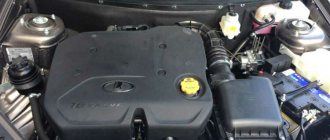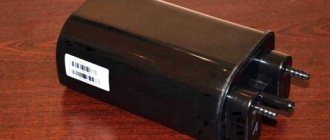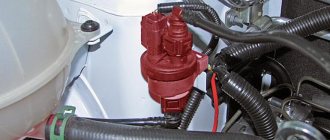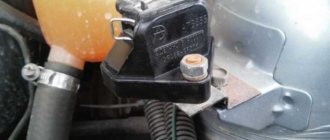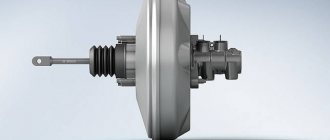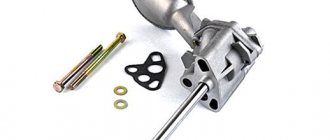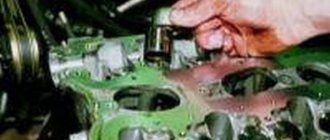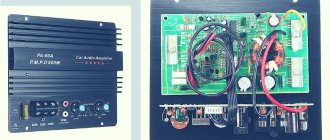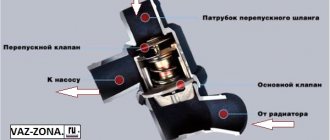From the article, the reader will learn why a sensor and an absorber purge valve are installed on a vehicle. What malfunctions occur with these devices and how to fix them yourself, without resorting to the help of experienced mechanics at a service station.
And here is a little about electrical circuits on Toyota cars.
Problems that lead to breakdown of the fuel pump or even the engine sometimes appear due to malfunctions of secondary devices. New car owners do not pay attention to minor breakdowns, confuse them with other problems and do not go to a service center to have the vehicle undergo a routine inspection.
Such secondary devices include the absorber valve and the gravity valve, located in the same system as the first. A gravity device is needed to block the flow of fuel from the gas tank to the outside when the car overturns.
What is an adsorber for?
Environmental standards provide for restrictions on exhaust gases emitted into the atmosphere by vehicles. Every year the standards become stricter. Car manufacturers have come up with special devices that protect the natural environment from exhaust gases from internal combustion engines.
Such devices are called adsorber. Although it correctly sounds like “Absorber” from the Latin word “Absorbeo” - “to absorb”. These devices are installed on gasoline engines of all vehicles.
This is what adsorbers look like for various car brands:
Adsorber VAZ
Audi adsorber
Toyota adsorber
New car owners are often interested in where the EVAP . This is the name of the equipment that is installed in cars and acts as a trap for harmful vapors. It includes an absorber valve.
Canister valves of various models:
Toyota canister valve
Audi canister valve
VAZ adsorber valve
EVAP stands for Evaporation Emission. In Russian it means the gas tank ventilation system. Comes from the Latin word - Evaporation or evaporation.
Attention! The adsorber is a secondary component in car engines. But its breakdown negatively affects the engine and its components.
Experts advise that if signs of malfunction of this device appear, contact a machine repair service center.
How to replace?
Replacing this part yourself is not difficult. If there are signs of a malfunctioning adsorber, do not hesitate - replace it. It will only take a few tens of minutes. So, we buy the necessary spare part (and it is inexpensive). We will need several clamps, bolts, and tools. Yes, and don’t forget to replace the hose, as it may also be “broken.”
According to the requirements of new environmental standards that limit the content of harmful substances in exhaust gases, vehicles must be equipped with an EVAP system. This equipment prevents harmful fuel fumes from entering the atmosphere. The main function in the fuel vapor recovery system is performed by the adsorber. Some people underestimate the importance of this element in the operation of a car. However, a malfunction of this seemingly minor component can lead to damage to the fuel pump and affect the operation of the entire engine. Therefore, experts recommend checking the adsorber valve when signs of engine malfunction appear.
Where is
On most cars it is located under the ignition coil, on the left side of the engine. To remove it, you need to remove the battery terminals, loosen and remove the mount, and remove all the hoses that are connected to it.
Locations of the adsorber in various brands of cars:
Operating principle of the adsorber
To understand where it is located and how to repair the blower, you need to know the operating principle of the device and the entire system. The absorber device itself is filled with activated carbon, which absorbs harmful substances.
EVAP catches gases from burned fuel as follows:
- Fuel vapor enters the separator. Condensation occurs. The resulting drops flow into the tank.
- Those vapors that have not turned into condensate flow into the absorber. Here the harmful substances they contain are absorbed by activated carbon.
- Gas accumulation occurs. And when the engine starts, they are supplied to the intake manifold.
- Absorption occurs when the engine is not running.
- When the engine starts, this very valve comes into action. It provides air flow from outside.
- Together with the air stream, the accumulated gases in the adsorber return to the engine.
- Here they undergo another burning.
- Now these vapors enter the exhaust system.
Thus, the absorber purge apparatus creates ventilation of the mechanism. Proper operation of the device is silent. During the cold season, the driver may hear a chattering sound on some cars. This is how the device works.
In case of any malfunction, the car owner will hear knocking, grinding, clattering sounds and blame the faulty engine for everything. In fact, the problem may be in the blower. Sometimes the purge sensor fails.
Attention! In order not to personally disrupt the operation of the ventilation system, experts do not recommend filling the car up to the neck of the gas tank. It is also recommended to promptly remove the pistole from the gas tank at gas stations.
What is the problem
The tank capacity is limited to a certain volume. The amount of gasoline vapor depends on the ambient temperature and how full the tank is with fuel. It is almost impossible to have a constant 100% charge, so vapors are constantly being formed.
With a minimum gasoline content in the tank, their quantity increases. Over time, a banal clogging of the carbon filter element occurs, and then the solenoid valve for purge the adsorber goes out of order.
As a result, excess pressure begins to appear in the fuel system, which causes and leads to:
- low fuel pump performance;
- the appearance of gasoline in the intake tract of the manifold;
- malfunction of the oxygen sensor (lambda probe);
- reduction of catalyst life.
Normal EVAP operation occurs as follows. Gasoline vapors are concentrated in the adsorber, which is connected by fuel pipes to the tank. An atmospheric pipeline is connected to it, creating a pressure difference for purging. It is connected to the air filter.
The third line is connected to the line of the solenoid valve, which provides a directed supply of vapor for afterburning in the intake manifold. The canister purge valve is controlled according to an algorithm in the ECU, which opens when a certain number of crankshaft revolutions other than idle speed (idle) is reached.
The engines are equipped with a gravity valve that prevents the fuel mixture from leaking out if the normal position of the vehicle changes, for example, when it turns over.
In engines with turbines, it is impossible to achieve air rarefaction without installing an additional valve, so an electromagnetic valve, called a two-way valve, is installed in the gasoline vapor recovery system. The functions of this element are to create the required pressure in the intake manifold when the turbine is not running and redirect it to the compressor when it is turned on.
Symptoms of a problem
The driver will feel a malfunction in the device immediately. The following happens to the car:
- engine power decreases;
- dips appear during engine idling;
- when opening the gas tank cap, the car owner hears it making a hissing sound. This indicates that the EVAP system is not ventilated;
- the smell of burning fuel in the vehicle appears in the cabin;
- Gasoline consumption per 100 kilometers increases.
The fuel pump breaks down due to the vacuum occurring in the system. This happens because without ventilation, fuel accumulates in the intake manifold. The engine will idle or may stop completely.
You can check whether the device is faulty or not by sharply pressing the gas pedal while driving. If the knocking and grinding noises remain, then the problem is in the adsorber.
Attention! The device can be adjusted using a special screw. If you tighten it half a turn, you can reduce the natural knocking of the device. When twisted one full turn, the controller will generate an error.
The adjustment itself will make the operation of the unit adequate and soft. It will stop knocking while driving and getting on the nerves of drivers. But in order to unscrew it, the car owner will have to clean the screw from the epoxy resin.
Determining the health of an element
To determine whether the system purge sensor and the device itself are working properly, you can use the error codes on the electronic engine control unit. Or do it mechanically yourself.
The car owner will need the following tools:
- multimeter;
- wire sections.
Absorber testing steps:
- Open the hood and disconnect the block with wires from the valve.
- The dipstick with a negative value is placed on the body. And with a positive one - to the terminal of the wire block under the name “A”. Each pin has its own designation, which can be found in the vehicle’s operating manual. At this point, the valve sensor output is needed.
- Turn on the ignition and look at the multimeter display.
- If it shows 12 Volts, then this means that everything is normal. If no electric current is supplied to it, then the multimeter will show 0. This means you need to check the battery.
Errors of a faulty unit that can be generated by the electronic engine control unit when a scanner is connected:
- break in the control circuit of the absorber purge valve;
- "Check Engine" signal;
- errors 0443, 0449;
- 0451 – is responsible for the readings of sensors in the gas tank. If it lights up, there is a malfunction in the sensors;
- 0442 – there is a leak in the engine ventilation system;
- 0455 - indicates that the leak in the ventilation system is large;
- error P0441.
To check the valve itself for malfunction, you need to remove it. Removal procedure:
- Remove the plunger from the injection syringe.
- Insert it into the outlet fitting on the device.
- Put pressure on him. The piston must move under pressure.
- After this, connect the battery to the electrical part of the valve. Press the piston again.
- If it moves under pressure, it is not working properly. If the piston goes down without resistance, then everything is in order.
Here you can find out where the Toyota starter is located.
The procedure for removing the adsorber
When purchasing a new vehicle engine ventilation unit, pay attention to the markings. Both should be identical. Otherwise, there will be no compatibility and the valve will not be able to work and provide ventilation to the gas tank.
The replacement procedure is as follows:
- Remove the negative terminal from the battery.
- Open the hood and find the absorber.
- Press the latch that holds the wire block. And disconnect it.
- Unscrew the screws that hold the device in place.
- Disconnect the hoses.
- Remove the bracket and the old piston from the absorber.
- Install a new device.
- Repeat all steps in reverse order.
Attention! To assemble in the same order, you need to mark each device with a marker in what order it was removed.
In this simple way, a new device for venting the EVAP system is installed.
Like all devices, this type of absorber has its positive and negative sides. Due to the disadvantages, experienced car owners most often remove the valve. Although this threatens to destroy the coordinated work of the mechanisms.
How to check the adsorber valve
If after checking it turns out that the adsorber is in more or less working condition, then it makes sense to check its purge solenoid valve. It’s worth mentioning right away that for some machines, due to their design, some actions will differ, some of them will be present or absent, but in general the verification logic will always remain the same. So, to check the adsorber valve, you must perform the following steps:
- Visually check the integrity of the rubber hoses included in the fuel vapor recovery system, in particular those directly approaching the valve. They must be intact and ensure the tightness of the system.
- Disconnect the negative terminal from the battery. This is done to prevent false alarms of the system diagnostics and to enter information about the corresponding errors into the electronic control unit.
- Remove the absorber (usually it is located on the right side of the engine, in the area where the air system elements are installed, in particular the air filter).
- Turn off the electrical power to the valve itself. This is done by removing the electrical connector (the so-called “chip”) from it.
- Disconnect the inlet and outlet air hoses from the valve.
- Using a pump or medical bulb, you must try to blow air into the system through the valve (into the holes for the hoses). It is important to ensure the tightness of the air supply. To do this, you can use clamps or a thick rubber tube.
- If everything is in order with the valve, it will be closed and air will not be blown through. Otherwise, its mechanical part will fail. You can try to restore it, but this is not always possible.
- It is necessary to supply electric current from the power supply or battery using wires to the valve contacts. At the moment the circuit closes, you should hear a characteristic click, which signals that the valve has actuated and opened. If this does not happen, then perhaps instead of a mechanical failure there is an electrical failure, in particular, its electromagnetic coil has burned out.
- With the valve connected to an electric current source, you must try to blow air into it in the manner described above. If it is working properly, and therefore open, then this should work without problems. If it is not possible to pump through air, then the valve has failed.
- Next, you need to reset the power from the valve, and there will be a click again, indicating that the valve has closed. If this happens, it means the valve is working.
You can also check the adsorber valve using a multifunctional multimeter, switched to ohmmeter mode - a device for measuring the insulation resistance value of the electromagnetic winding of the valve. The probes of the device must be placed at the coil terminals (the places where the wires coming from the electronic control unit are connected to it; there are various design solutions), and the insulation resistance between them must be checked. For a normal, serviceable valve, this value should be within approximately 10...30 Ohms or differ slightly from this range. If the resistance value is small, it means that there is a breakdown of the electromagnetic coil (short interturn circuit). If the resistance value is very large (calculated in kilo- and even mega-ohms), then the electromagnetic coil breaks. In both cases, the coil, and therefore the valve, will be unsuitable for use. If it is sealed into the housing, then the only way out of the situation will be to completely replace the valve with a new one.
Positive and negative aspects of adsorber
The advantages of the device include the following protection functions that it performs:
- the car does not emit harmful gases into the atmosphere;
- saving fuel, as unexhausted vapors burn out;
- There is no unpleasant smell from fuel in the cabin. This item is not performed at the proper level on some modifications of vehicles.
The negative aspects of the adsorber include the following parameters:
- instability of engine operation when the valve is dirty;
- takes up a lot of free space under the hood;
- the cost of installing an absorber is high. Accordingly, the vehicle itself becomes more expensive;
- the tank cap may fly off if the valve is not working properly and gases accumulate inside the gas tank;
- if the device fails, this results in the loss of the fuel pump;
- large accumulations of an explosive mixture if the absorber is faulty, but the engine continues to operate. This happens with older car models produced before 2000.
Many car owners remove this device. Since some drivers are sure that the device leads to increased fuel consumption. Others say that it causes the fuel pump to break and the engine itself will not last long.
When removing the absorber, the car owner should know that the tube from the valve must be closed. And adjust the program in the electronic control unit. Therefore, it is better to perform this procedure in the presence of experienced mechanics or at a service center. Although many mechanics do not want to remove the device and will try their best to dissuade the car owner.
Adsorber repair
Manufacturers do not provide precise information regarding the frequency of replacing the adsorber filter, but experts recommend doing it after 80-100 thousand kilometers or as needed. It has a non-demountable design, so it is not subject to maintenance. All operations related to its repair are carried out at your own peril and risk. If you nevertheless decide on this procedure, then you will only need an electric engraver. Materials: coal, possibly felt and high-quality glue.
Usually the adsorber is located under the hood on the right side in the direction of travel of the car. Before removing, dismantle it, marking all the tubes included in it. If it is made of plastic, then it needs to be disassembled. To do this, cut off the cover with an electric engraver from the side where the tubes are supplied. Next, remove the felt pad and blow it with compressed air, and wash it if necessary.
Accurately determine the volume of carbon elements and replace them with fresh ones. Reassemble in the reverse order, ensuring the most reliable connection using glue.
To confirm the correctness of the operations, test the operation of the EVAP system before and after installing the filter using diagnostic programs and a PC. After installing a new filter or repairing it, the dependence of engine operation on the EVAP system will be revealed on the graphs; usually this is not observed in an incorrectly operating filter.
If a valve or filter element is not replaced in a timely manner, the fuel pump will fail most quickly, because it needs to work “harder” to create more pressure in the fuel line, constantly overcoming the vacuum in the pipelines.
It will also be interesting: Anti-rain - myths and reality
